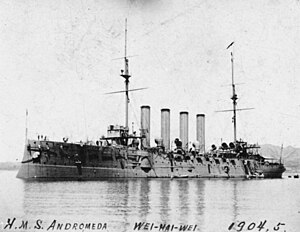HMS Andromeda (1897)

|
|
| History | |
|---|---|
|
|
|
| Name: | Andromeda |
| Namesake: | Andromeda |
| Builder: | Pembroke Dockyard |
| Laid down: | 2 December 1895 |
| Launched: | 30 April 1897 |
| Completed: | 5 September 1899 |
| Renamed: |
|
| Reclassified: | As a training ship, 23 September 1913 |
| Fate: | Sold for scrap, 1956 |
| General characteristics | |
| Class and type: | Diadem-class protected cruiser |
| Displacement: | 11,000 long tons (11,177 t) |
| Length: | 435 ft (132.6 m) (p/p) |
| Beam: | 69 ft (21.0 m) |
| Draught: | 25 ft 6 in (7.8 m) |
| Installed power: |
|
| Propulsion: |
|
| Speed: | 20.5 kn (38.0 km/h; 23.6 mph) |
| Complement: | 677 |
| Armament: |
|
| Armour: | |
HMS Andromeda was one of eight Diadem-class protected cruisers built for the Royal Navy in the 1890s. Upon completion in 1899, the ship was assigned to the Mediterranean Fleet where she helped to escort a royal yacht during its cruise through the Mediterranean Sea. After a refit, she was assigned to the China Station in 1904 and returned home three years later to be reduced to reserve. Andromeda was converted into a training ship in 1913 and remained in that role under various names until 1956. That year she was sold for scrap and broken up in Belgium, the last Pembroke-built ship still afloat.
The Diadem class was designed to protect British merchant shipping from fast cruisers like the Russian Rurik and were smaller versions of the Powerful class. The ships had a length between perpendiculars of 435 feet (132.6 m), a beam of 69 feet (21.0 m) and a draught of 25 feet 6 inches (7.8 m). They displaced 11,000 long tons (11,000 t). The first batch of Diadems were powered by a pair of four-cylinder triple-expansion steam engines, each driving one shaft, which were designed to produce a total of 16,500 indicated horsepower (12,300 kW) and a maximum speed of 20.5 knots (38.0 km/h; 23.6 mph) using steam provided by 30 Belleville boilers. They carried a maximum of 1,900 long tons (1,930 t) of coal and their hulls were sheathed with copper to reduce biofouling. Their complement numbered 677 officers and ratings.
...
Wikipedia
